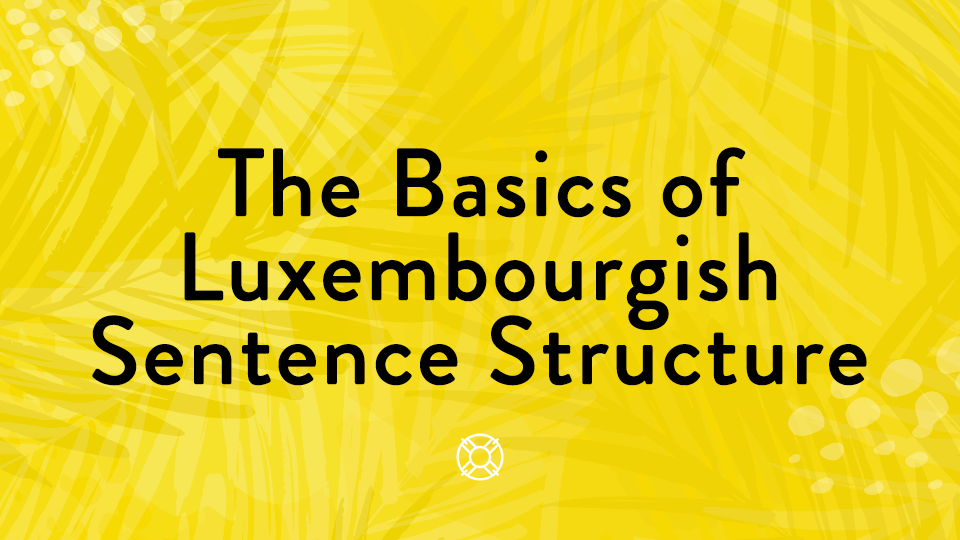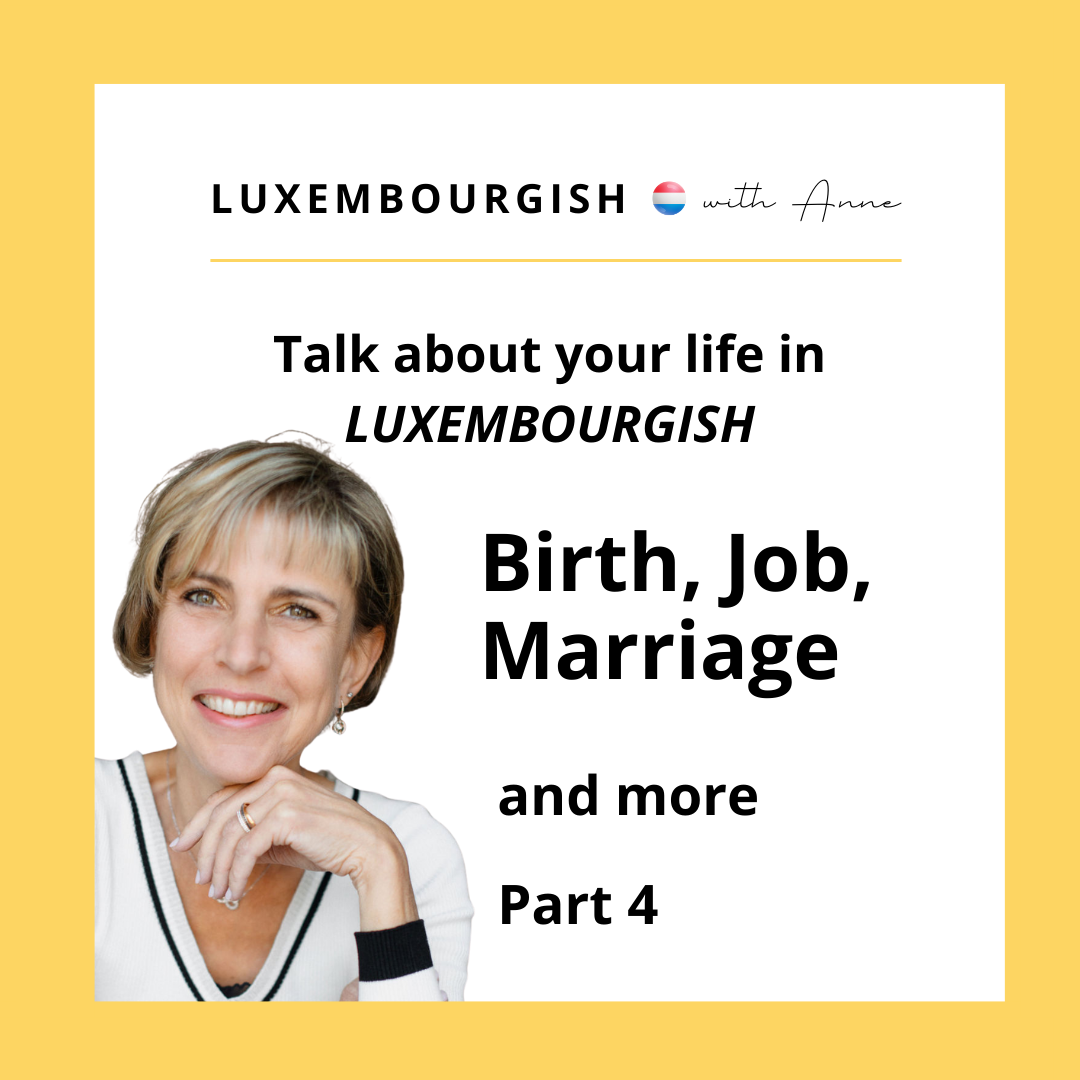While there are cases in which Luxembourgish and English word order are identical, the word order in Luxembourgish is more variable and flexible than in English. In particular, sentences need not begin with the subject. BUT there are strict rules determining the position of the VERB and there are a few other rules to bear in mind.
And as there is much to say about the word order in Luxembourgish sentences I decided to create an online course – 10 day course: Understand the Basics of Luxembourgish Sentence Structure!
1. The Verb is Always the Second Element
No matter which element begins a Luxembourgish declarative sentence (a statement), the verb is always the second element. If you remember nothing else about Luxembourgish word order, remember this. The subject will either come first or immediately after the verb if the subject is not the first element. This is a simple and fast rule. In a statement (not a question) the verb always comes second.
This rule applies to sentences and phrases that are independent clauses.
A “normal” word order places the subject first, the verb second, and any other elements third.
Examples:
Ech léieren haut Lëtzebuergesch. – I learn Luxembourgish today.
Haut léieren ech Lëtzebuergesch. – Today I learn Luxembourgish. (Lit: Today learn I Luxembourgish)
Remark:
a) Throughout this lesson, note that verb refers to the conjugated verb, so, the verb that has an ending that agrees with the subject (hien ësst, du schaffs .. etc.).
b) Also, “in second position” or “second place,” means the second element, NOT necessarily the second word.
Only one element can precede the verb, but it may consist of more than one word, for example Haut den Owend.
In such cases, the verb remains second and the subject must immediately follow the verb:
⇒Haut den Owend léieren ech Lëtzebuergesch. –This evening I learn Luxembourgish.
2. Time, Manner and Place: Wéini, Wéi, Wou
Another area where Luxembourgish syntax may vary from that of English is the position of expressions of time wéini?, manner wéi? and place wou?
In English we would say, Tom is coming home by train today. English word order in such cases is place, manner, time… the exact opposite of Luxembourgish. In English it would sound odd to say, Tom is coming today by train home, but that is precisely how Luxembourgish wants it said: time, manner, place.
Examples:
Den Tom kënnt haut mam Zuch heem. ⇒ haut (time), mam Zuch (manner), heem (place).
Ech ginn all Dag mam Auto op d’Aarbecht. ⇒ all Dag (time), mam Auto (manner), d’Aarbecht (place). – I go to work by car everyday.
3. Sentence Bracket
When you have a separable verb (with a prefix), a modal verb or when a verb is used in combination with a second verb then the conjugated verb still stays in POSITION 2. This creates a sentence bracket that contains all of the other information.
Examples:
Meng Mamm fiert normalerweis um 6 Auer heem. – My mom usually goes home at 6pm.
Here we have a separable verb heemfueren. ⇒ fueren is the stem and heem is the a prefix.
For such verbs, the prefix is separated from the stem and placed at the end of the sentence in the present tense (as long as the clause is not subordinate or relative).
Meng Mamm wëll haut um 6 Auer heemfueren. – My mom wants to go home at 6pm today.
Here we have the modal verb wëllen (the conjugated verb) and the 2. verb comes at the very end of the sentence. In this case a separable verb is no longer separated.
Meng Mamm ass haut um 6 Auer heemgefuer. My mom came home at 6pm today.
Here we use the present perfect: the conjugated verb sinn and the past participle heemgefuer
Remark:
a) The first verb-second exception is for dependent or subordinate clauses. In subordinate clauses the verb always comes last. You can read about the word order in subordinate clauses in this lesson and if you want to understand why the Luxembourgish sentence structure sometimes changes and if you want to practice then I invite you to enroll in my online course.
b) One other exception to this rule: interjections, exclamations, names, certain adverbial phrases – usually set off by a comma.
Examples:
Nee, meng kleng Schwëster geet haut net eraus.
Anne, ech kann haut net an de Cours kommen. Anne, I cannot come to the class today.
Wéi gesot, ech kann haut net kommen. As I said, I cannot come today.
In the sentences above, the initial word or phrase (set off by a comma) comes first, but does not alter the verb-second rule.
Summary :
1 Simple, declarative sentences are identical in Luxembourgish and English: Subject, verb, other.
2 The verb is always the second element in a Luxembourgish sentence.
3 Luxembourgish sentences are usually “Time, Manner, Place.”
4 With separable, modal verbs and tenses, the second verb goes last, but the conjugated verb is still second.
*Learn more about the word order in subordinating clauses and about conjunctions in this lesson.
Übung (exercise)
Practise with this FREE lesson of my online course 10 day course: Understand the Basics of Luxembourgish Sentence Structure or by downloading the PDF copy of this lesson!
I hope you liked it and found it useful. And …. why not sharing this lesson with your friends:-)
Want to learn more about the correct word order? Then this course is for you:
10-Day-Course: Understand the Basics of Luxembourgish Sentence Structure!






